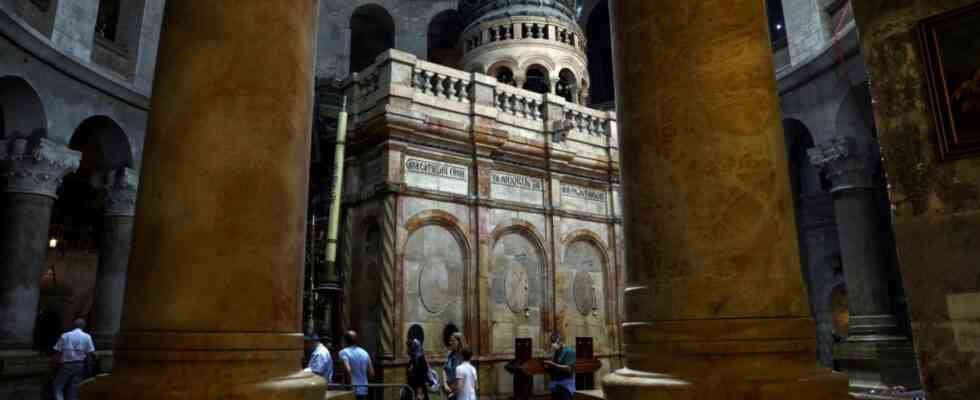A wooden cross, almost two meters tall, stands alone at the beginning of the Via Dolorosa. It was posted here by the Canaan family who secured the rental business on the Street of Sorrows generations ago. Admittedly no one has yet been found who would pay a fee to take up the cross and carry it through the Old City of Jerusalem up to Golgotha in the imitation of Christ. But at least a few potential customers are showing up, and that’s good news: the pilgrims are back in Jerusalem. After two years of silence due to the pandemic, Easter is once again properly celebrated in the Holy Land.
It was already a cross with Corona: At Easter 2020 even the Church of the Holy Sepulcher was closed due to the lockdown. In 2021, Ben Gurion Airport was still closed to foreign visitors. But now everything is open again, and life has awakened again in Jerusalem’s old town on the Feast of the Resurrection.
Anyone who pays a fee can borrow the almost two-meter-tall wooden cross at the beginning of the Via Dolorosa and drag it up to Golgotha.
(Photo: Peter Münch/SZ)
However, anyone who goes in search of clues on the Via Dolorosa, which with its 14 stations meanders as the nucleus of all the Ways of the Cross to the Church of the Holy Sepulchre, will quickly notice that this is still a long way from the pious hustle and bustle of earlier years. According to the Israeli Ministry of Tourism, 30,000 foreign guests will come to Israel around Easter this year. That is 70 percent less than before the pandemic, and not all of them are Christians because the Jewish Passover festival is also celebrated at the same time from Friday.
In the Austrian Hospice, which has been accommodating pilgrims at number 37 on the Via Dolorosa since 1863, the mood is “quite positive”. A few of the 107 beds remained free even during Holy Week. “That’s absolutely unusual,” says guest house manager Lucas Maier. But overall, the utilization is again at 60 to 70 percent. “For many, this is a long fast that is coming to an end.”
Ghassan Attieh runs a shop at the Crossroads in Jerusalem. On the way to the Church of the Holy Sepulchre, you can stock up on candles and oil – and crowns of thorns.
(Photo: Peter Münch/SZ)
This also applies to the countless tour guides who now again gather their travel groups in front of each Station of the Cross and explain where Jesus fell on his way of suffering, where he met his mother Mary and where Veronica handed him the veil. And even the many dealers for whom complaining is part of their business breathe a sigh of relief these days. Depending on the season, they have put the crowns of thorns at the front of their displays. You can get them from Ghassan Attieh for 30 shekels each, the equivalent of eight euros. From the plastic chair in front of his shop, he calls out to the pilgrims on their way to the Church of the Holy Sepulchre: “Do you want candles, some holy oil?”
Father Jakobus-Maria thinks it’s nice that people are coming back. Even nicer if there aren’t so many.
(Photo: Peter Münch/SZ)
Inside the church itself, Babylonian confusion reigns around the burial chamber from which, according to tradition, Jesus rose from the dead. “Holy and Easter days” are always big days for us,” says the Franciscan Father Jakobus-Maria, who lives here in a good mood. “Of course it’s good that people can be here again,” he explains. “But so many we really don’t want to. It’s nice now, so you can still breathe.”

